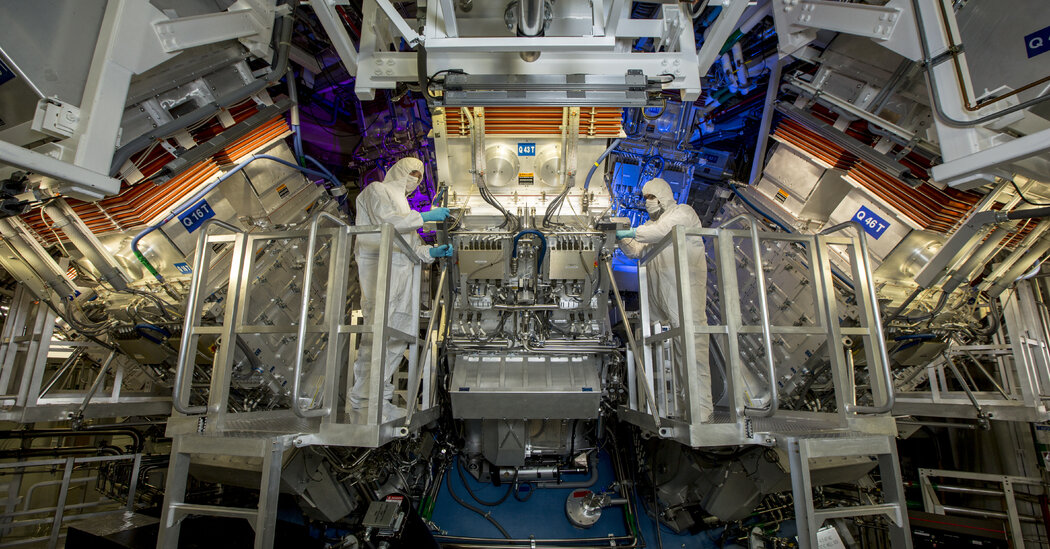|
Getting your Trinity Audio player ready...
|
If you enjoy science fiction, you might have heard of nuclear fusion. In the real world, fusion is what powers the sun. In some sci-fi tales, humans in a far-flung future have learned how to wield fusion for an end-all, be-all source of energy — one that is abundant and does not pollute the environment or release dangerous levels of radioactive waste.
Yesterday, scientists at the Department of Energy announced a breakthrough that could help make that sci-fi vision into reality. After decades of trying, scientists for the first time carried out a nuclear fusion reaction that produced more energy than went into it. Behind that technical description is a simple but important breakthrough: Humans can tap into the process that powers stars to produce energy on Earth.
“It’s a true scientific moment,” my colleague Kenneth Chang, who covers physics and other sciences, told me. “It lets you look forward and get hopeful about what’s possible.”
Why is this result such a big deal? As a clean source of energy, nuclear fusion could help replace polluting fossil fuels and overcome climate change. And if the remaining challenges — of which there are many — are figured out, nuclear fusion could produce more energy than today’s technologies are capable of.
Serious barriers remain before that potential future, experts caution. Can scientists reliably replicate what they’ve done only once? Can it be done more efficiently and more quickly? Can it be scaled up? All these questions are serious enough that, if not overcome, yesterday’s announcement may ultimately amount to little.
Anything involving nuclear science can get technical and complicated fast. In today’s newsletter, I want to walk you through some of the basics so you can understand why the announcement could be a big discovery.
Imitating the sun
Fusion is what powers the sun and other stars. The sun’s massive gravitational pull constantly compresses hydrogen atoms and fuses them into helium, releasing bursts of energy. That energy is transmitted across the solar system as light and heat, in rare circumstances creating the conditions for life.
Back on Earth, scientists hope to replicate a tiny fraction of that process to power our other technologies and infrastructure, without emitting the climate-warming emissions that coal, oil and gas do or the radioactive waste that current nuclear power plants do.
Most nuclear fusion experiments have used doughnut-shaped reactors and magnetic fields to trap hydrogen, fuse it and release energy. Those experiments have not yet produced more energy than they used — the goal they need to meet to be considered a true source of energy.
What the Department of Energy’s lab did was different. It fired 192 lasers at a tiny hydrogen pellet. This heated up the pellet, causing it to implode, fuse into helium and release a blast of energy.
The lab had been conducting this experiment for years, tweaking how and where the lasers are fired. On Dec. 5, the changes paid off: The resulting nuclear fusion produced more energy — about 50 percent more — than the incoming energy from the lasers. (Although firing the lasers uses more energy — a different problem to solve.)
“They can say unequivocally that they did a nuclear fusion reaction that produces more energy than goes in to start the reaction,” Kenneth said. “Nuclear fusion research has been around for 50 years, and no one has been able to say that before.”
The goal now is to refine this approach further, hopefully to make it commercially viable and eventually to supplant other, dirtier sources of energy.
Remaining barriers
As exciting as the results are to scientists, they acknowledged that potentially decades of work remain before this breakthrough leads to widespread commercial use, if it ever does.
For one, scientists have achieved this kind of fusion reaction exactly once. Commercial use would require facilities to reproduce that result reliably and constantly, firing lasers up to 10 times a second.
Some of the fuel used for this particular process could also be hard to come by. Other possible fuels exist — potentially from mining the moon (yes, that’s as wild as it sounds) — but those would require a whole different set of breakthroughs to obtain and use.
And there are more practical questions about cost and scale. The Department of Energy’s laser complex takes up the equivalent of three football fields, Kenneth noted — “too big, too expensive, too inefficient for a commercial power plant.”
Yet it’s typical for scientific breakthroughs to start in unrealistic lab settings before they are refined for public use. At the very least, this discovery shows that nuclear fusion can be a source of energy. Now the work begins to try to turn that into a usable technology.
For more
THE LATEST NEWS
Business
A delicious 2022
This was a year of restaurant openings in New York, reaching “an almost frantic, Lucy-in-the-chocolate-factory speed in the past few weeks,” the Times critic Pete Wells writes. And while the economy did create some challenges for restaurants this year, including a labor shortage that prompted earlier closing times and shorter weeks, a lot of the city’s new establishments were well equipped to handle it.
Among the new restaurants, Pete picked 10 that stand out. They include a cafe in Midtown that feels like it’s in Milan, the city’s best Thai food, and a superb omakase sushi meal.
Affordable dining: If you’re looking for a meal that’s more in the $10 range, here are places in New York where you can get great food for reasonable prices.
Across the U.S.: These are the dishes that Times food critics are still thinking about.
PLAY, WATCH, EAT
What to Cook
The pangrams from yesterday’s Spelling Bee were blockable, cookable and lockable. Here is today’s puzzle.
Here’s today’s Mini Crossword, and a clue: $100, in slang (five letters).
And here’s today’s Wordle.
Thanks for spending part of your morning with The Times. See you tomorrow. — German
P.S. The League of Nations, a forerunner to the U.N., expelled the Soviet Union 83 years ago today for invading Finland.
Here’s today’s front page.
“The Daily” is about abortion.
Matthew Cullen, Lauren Hard, Lauren Jackson, Claire Moses, Ian Prasad Philbrick, Tom Wright-Piersanti and Ashley Wu contributed to The Morning. You can reach the team at [email protected].



